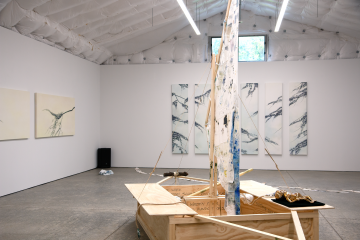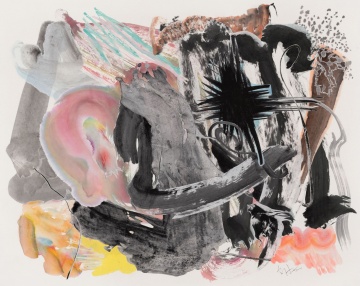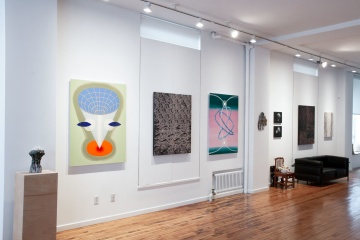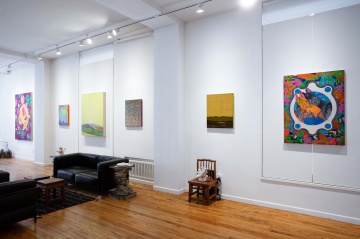Chambers Fine Art
55 East 11th Street, 5th Floor
New York, NY 10003
By Appointment
212 414 1169
Also at:
ArtFarm
Salt Point, NY
By Appointment
212 414 1169
New York, NY 10003
By Appointment
212 414 1169
Also at:
ArtFarm
Salt Point, NY
By Appointment
212 414 1169
Chambers Fine Art is a gallery specializing in contemporary Chinese art located in New York and Beijing. It was established by Christophe W. Mao in New York in 2000. Recognizing the need for a gallery that would serve as an authoritative source of information on the latest developments in the rapidly growing contemporary art world in China, Mao named his gallery after Sir William Chambers, the celebrated British architect who was a leading exponent of Chinese principles in garden design in the late eighteenth century. During the first seven years, artists including Lu Shengzhong, Hong Hao, Song Dong and Yin Xiuzhen had their first solo exhibitions in the USA. Since then a younger generation of artists including Wu Jian’an, Zhao Zhao, Fu Xiaotong, and Guo Hongwei has added different perspectives to the gallery profile. From 2009 to 2019 the gallery has occupied premises at 522 West 19th Street, a block that is noteworthy for a concentration of new buildings by Frank Gehry, Shigeru Ban and Jean Nouvel as well as proximity to the High Line, the former elevated railway track that has become a much admired public park. In the fall of 2019, the gallery headquarters moved to an appointment-only viewing room in Greenwich Village, supplemented by an exhibition space on the Lower East Side. As it enters its third decade, the inclusion of a generation of younger artists, not all of them from China, into the gallery's program indicates a widening of scope, a shifting of perspective. Chinese contemporary art has become readily accepted within the international dialog, and by broadening its focus, Chambers Fine Art aims to further enrich this dialog.
Artists Represented:
Ai Weiwei 艾未未
Angela Lyn 林安琪
Cai Jin 蔡锦
Cui Fei 崔斐
Fu Xiaotong 付小桐
GAMA
Guo Hongwei 郭鸿蔚
Hong Lei 洪磊
Ho Sin Tung 何倩彤
Lam Tung-pang 林东鹏
Lucy Liu
Lu Hui 卢辉
Lu Shengzhong 吕胜中
Miranda Zhang 张丰渊
Pixy Liao 廖逸君
Shi Chong 石冲
Song Dong and Yin Xiuzhen 尹秀珍和宋冬
Song Hongquan 宋红权
Taca Sui 塔可
Wang Dongling 王冬龄
Wu Jian'an 邬建安
Xie Xiaoze 谢晓泽
Yan Shanchun 严善錞
Zhao Zhao 赵赵
Zheng Chongbin 郑重宾
Works Available By:
Antonia Kuo
Antonia Kuo
Yi Cao
Shuyi Cao
Tiger Chengliang Cai
Emily Cheng
Furen Dai
Mengbo Feng
Jenny Perlin
Lao Tongli
Mary Simpson
Hong Hao
Jenny Perlin
Rongrong & Inri
Siyuan Tan
Song Dong
Song Xin
Shi Jinsong
Tan Dun
Wang Tiande
Yang Jiechang
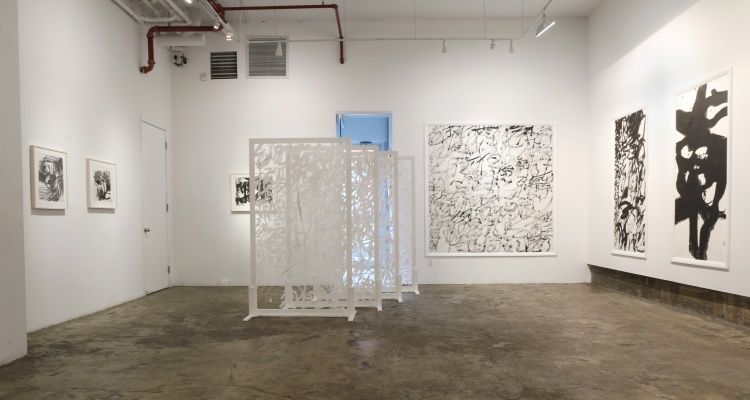
Installation view courtesy Chambers Fine Art.
WU JIAN’AN
WU JIAN’AN: RECENT WORKS
September 8, 2022 - December 23, 2022
Chambers is delighted to present the latest examples of Wu Jian’an’s ongoing series 500 Brushstrokes, on which work commenced in 2016. The abstract formal language characteristic of these works came as a considerable surprise to Wu’s admirers as until then there had been a strong element of figuration in all his major series of paper cuts from 2003 onwards with the series known as Daydreams. Alongside the works from this series, we will also feature a paper-cut piece entitled Shapeshifting Diety, created using Wu Jian'an's signature waxed paper-cut figures that are hand-dyed and then stitched onto a silk background.
Born in Beijing in 1980, Wu Jian’an graduated from the Central Academy of Fine Art (CAFA) Beijing in 2005 and currently lives and works there. While studying at the Academy under Lu Shengzhong whose early studies of Chinese folk-art led to a life-long involvement with the traditional craft of paper cut, Wu conceived of ways in which this technique might be used in ways that would have been unimaginable to its original practitioners. His technique evolved from the silhouetting of complicated paper cut-outs against monochromatic sheets of paper to the use of multiple layers of paper of different colors resulting in low-relief effects. Throughout this period his paper cutting skills gained in complexity as his enthusiasm for Chinese mythological themes and esoteric imagery from all over the world became all-consuming, culminating in the process used in the Shapeshifting Diety.
There does not seem to have been a transition period between the wild paper cuts for which he was best known at the time and the equally wild but abstract compositions characteristic of 500 Brushstrokes. Certainly while at the Academy he seems to have stayed away from the study of Chinese painting with its close relationship to the most important of all Chinese accomplishments, the art of calligraphy. On first inspection the works from this series seem to be calligraphic in inspiration and, with their frequently jazzy colors, to be laid down directly on the surface of the support. Wrong on both counts as the relationship to traditional calligraphy is distant to say the least and close inspection - very close inspection, even! - reveals, although with some hesitation at first, that the calligraphic components are not applied directly to the surface but applied to it in the manner of collage.
Wu Jian’an gave a simple explanation early on in the development of the series. “Visitors of all kinds are invited to the studio to play a brushstroke ‘game’. They can freely pick the size and type of the brush, as well as choose the the density of ink and colors in order to write a single brushstroke on a sheet of Xuan paper in whatever style they choose, without creating a recognizable image or character… In traditional Chinese painting, brushstroke are highly regulated. As in a hierarchical society, only a limited number of accepted brushstrokes can be used. 500 Brushstrokes offers equal opportunity to all manner of brushstrokes, orthodox or not, all can go into an artwork. This creates a variety of previously unimaginable relations. Combinations consisting of ‘bad’ strokes often compose incredible images.”
Consequently Wu’s combinations of individual brushstrokes are as far as could possibly be both from traditional Chinese calligraphy which evidences the continuous movements of the calligrapher’s hand and from Western artists such as Jackson Pollock, Mark Tobey or Brice Marden who have responded to Asian calligraphy in highly individual ways.
The skill with which the individual strokes have been collaged to the surface on which they coexist also adds another dimension to the viewing experience. In a description of 500 Brushstrokes #10, 2016, that has recently entered the collection of the Metropolitan Museum of Art, New York, reference is made to the way in which the individual strokes are “collaged into the larger whole using traditional Chinese conservation techniques which allow for nearly seamless layering of paper on paper.” On multiple levels, then, these festive works are not what they seem - not calligraphic, not expressive of a meaning, not painted directly on a flat surface but rather organized by a masterly hand in a manner that fools the eye and delights the mind.
Oddly enough, there is a parallel between the circumstances in which Wu’s first series of paper cuts -Daydreams - were conceived and executed and the recent history of the latest examples of 500 Brushstrokes on display. Wu began working on the earlier series in 2003 when, confined to his room in Beijing because of the SARS epidemic, he picked up paper and scissors and found the practice therapeutic. The figures he created comforted him. Nearly twenty years later, he wrote that “These 500 Brushstrokes were completed in 2021. They spent over a year in transit at sea before landing in New York. Today, when I see them again in 2022, I have a sense of familiarity and strangeness. There is some sweetness hidden underneath, and feelings of hope and optimism. I feel that the time I created them was not long ago at a time when a force of gathering and wishing to generate something consequential was moving between the strokes, eager and calling out.”
For more information please contact us at cfa@chambersfineart.com
Tiger Cai, Shuyi Cao, Emily Cheng, Furen Dai, Antonia Kuo
Matter Matters
June 15, 2022 - August 26, 2022
In much of today’s world, the accelerating narrative of technology and progress has resulted in an overly narcissistic point of view, where humanity has developed the misguided belief of having control over all things. We ignore the idea of our own insignificance in the greater cosmos and lose the sense of wonder and awe of where we are and what is unknown. This line of thought has led people to settle for a controlled 'one-click away' world, with a desire to continuously optimize and refine technology.
The historic changes and upheavals in society due to the recent global pandemic have caused a sense of disorientation, uncertainty, and dislocation of physical and psychological time. The upheaval has exacerbated ongoing imbalances in the global political and economic systems, and has forced many of us to think outside of the established, “technological progress” paradigm once again. The artists in this exhibition seek to pull the lens farther away and humbly look at and explore the hidden, impenetrable, and unexplainable things. From their own carried perspectives, their work reflects upon human existence from a broader dimension of space and time, in an attempt to see where we are and how far we are from everything.
Shuyi Cao’s work looks at geological history, examining the traces of biological existence that have been compressed and condensed into the earth’s crust. Her hand-blown clear and colored borosilicate glass pieces (Many-heads, etc.) resemble an aerial view of some unknown topography. With distinctive forms that evoke preconscious memories of primordial microscopic organisms, these fantastical creatures exude a mixed sense of familiarity and estrangement, perhaps recognized from past incarnations of our very biological and geological origin; while simultaneously encoding the clues of future evolution. Precarious Encounter (2021) imagines the interspecies relationship between fungi and its host body, exploring another form of entangled life through contagion and co-becoming.
Antonia Kuo looks at the spontaneous interaction of matter itself, using a photographic process to create chemigrams that blur the boundary between photography and painting. Matter collides with matter in unpredictable ways, much like human encounters. Conventional prints are processed relatively quickly in the darkroom. Chemigrams, by contrast, can be worked on for days or weeks, time enough for Kuo to selectively apply coats of developer, toners, dyes, and fixer to her paper. Perhaps the most remarkable feature of the chemigram process is that the practitioner can rearrange and alter the chemical steps in the service of whatever effect she desires. In Carpet Beetle and Sieve (in mauve), Kuo integrates several processes of image production from different periods (analog, digital, exposure) into one. As she creates the works, seemingly unquantifiable traces of movement of matter, such as light and time, are transformed, recorded, and developed into images. Bouncing between the controllable and the uncontrollable, the manufactured and the mutated, Antonia's works ultimately present images that reveal the delicate balance between man and matter.
Furen Dai critiques the institutional art system, examining the essence and positioning of cultural institutions whose role in documenting human culture is crystallized in Western aesthetics and bias. Dai wryly challenges museums and their colonial origins through her fresco works that depict barren museum pedestals. Based on a video piece in which she depicts a dystopian future where humanity has been lost due to a global pandemic, the empty pedestals are revealing in their design - created to elevate the objects they hold, but also stylized in a manner that subtly reinforces the highly categorized and Westernized point of view. At the same time, Dai’s works reference the often-invisible labor of craftspeople who shape museum spaces, and build the platforms and containers that elevate and protect the collection.
Like Dai’s narrative, Tiger Cai also frames his works in an imaginary post-apocalyptic era, but presents his story of the destiny of the human species from a cosmic vantage point, literally set in outer space. The death of his pet goldfish served as the introductory lesson to life and death in his childhood, and thus became an ongoing metaphor for the afterlife in his paintings. As the fish sails into the unknown, Cai zooms out beyond the confines of the Earth, contemplating human existence as a small part of the larger universe. His comets and asteroids that appear to be alive, in stark contrast to the geological forms that inspire Shuyi Cao’s work.
Similarly ‘cosmic’ in nature, Emily Cheng's paintings are charged with conversations about spirituality and the unknown energy of the universe. Her paintings invite introspection more than commentary. She no longer gazes at what is happening in the Anthropocene but instead moves beyond the established framework of "society" and "civilization" to the realm of metaphysical reflection. The geometric patterns and vivid brushstrokes that make up her paintings are suggestive of elemental forces and subject matter: magnetic fields, the body, and religious iconography. Symmetrical, diagrammatic shapes interact with velvety colors and flexible, curved line-work, tapping into what Cheng describes as the "potential of unseen things or unknown force".
All five artists are based in New York, and although their works are highly individual, the manner in which they deal with their chosen subject matter share a similar sentiment. Even before the pandemic brought much of the world to a sudden halt, these artists chose to work from a perspective outside of the common narrative. Now, as the world struggles to return to normalcy, their work serves as a reminder that humanity is only one small part of a greater universe.
For more information please contact us at cfa@chambersfineart.com
Fu Xiaotong
NUN-3
March 31, 2022 - May 19, 2022
GAMA and Siyuan Tan
Betwixt
February 3, 2022 - March 25, 2022
Chambers Fine Art is pleased to announce the exhibition Betwixt, featuring artists GAMA and Siyuan Tan on February 3, 2022. This will be GAMA’s fourth exhibition with the gallery, and Siyuan Tan’s first time showing with Chambers Fine Art.
The shaman is a mediator between man and all things in nature. Its influence is particularly evident in northern mainland China, with various branches of the tradition existing within ancient Tungusic (Manchu) and Mongolian cultures. Acting as a bridge, the shaman connects man and nature, man and God to each other.
Both GAMA and Siyuan Tan use their unique artistic language to reference their own cultural lineage, conceptualizing the spiritual core and external symbols of mythology. Breaking away from a religious interpretation of these symbols, they instead search for new definitions and logical relationships between shamanic culture and the contemporary world from a personal perspective.
Born in Inner Mongolia in 1977, GAMA studied at the Central Academy of Fine Arts in Beijing from 1996 to 2000 before moving to Karlsruhe, Germany in 2002 where he studied painting at the Staatliche Akademie der Bildenden Künste from 2002 to 2007 and was master student under Gustav Kluge from 2007 to 2008. He currently lives and works in Berlin.
GAMA was born into a nomadic family and would move every four months as the seasons changed. His great aunt was an important shaman whose ability to connect with the supernatural world had a profound impact on the young boy. He recalls witnessing her communicating with the spirit world on many occasions to find out what evil demon had entered her body and caused a particular illness. There were also times when she entered into a trance-like state and animal cries came out of her mouth.
Nomadic elements and spatial dislocation are very prominent in GAMA's works. While he now lives and works in Germany, the paintings still reflect his nomadic freewheeling and infinitely curious mindset. In his work, GAMA focuses on creating a three-dimensional space for his characters in the form of oil on canvas. However, he does not use illusionism to confuse the viewer between the painting and the real world; instead, he juxtaposes cultural and visual references, and emphasizes the texture of the work itself. In GAMA’s images, paint is piled up on the edges of irregular shapes as if it would fall off the canvas. In Manöver #2, the vast prairie and mountains are endless, while a massive cluster of mushrooms grows in the middle of the scene. The sky is broken by a simple lamp, presenting a hybrid of interior and exterior spaces; an ‘in-between’ space that appears often in the artist’s work.
Born in 1984 in Fuxin, Northeast China, Siyuan Tan graduated from the Lu Xun Academy of Fine Arts with a BFA in sculpture and the Savannah College of Art and Design with an MA in sculpture. He currently works and lives in New York. Fuxin, the hometown where he lived as a child, was once the top energy city in Asia in terms of coal production, and people had to live in the city above ground as well as work in the mines underground. This dichotomy between positive and negative, between above and below in turn inspired his interest in spatial connections, not only physically but also in a spiritual sense.
Related to this, the real world and the virtual ‘underworld’ are also important concepts in Siyuan Tan's work. Drawing from his Manchu heritage, he employs a series of elements from Manchu-Tibetan Buddhism and shamanic culture in this recent paintings, such as the unique spatial overlapping relationship found in Thangka paintings, and depictions of the “psychic eye”, connecting the earthly and spiritual realms. In Tan’s painted universe, enchantment coexists with roving tension, underscored by the artist’s kaleidoscopic color palette. In The Way, the Fuxi and Nvwa (the original gods who created humanity according to Chinese legend) are depicted with intertwined snake-like bodies, and are surrounded by Bagua, Taoist diagrams that represent the fundamental principles of reality and seen as a range of eight interrelated concepts. The dynamic equilibrium between yin and yang, masculinity and femininity, and the symmetry of the images make Tan's work appear orderly and disciplined, while elements such as mist and vines interrupt the viewer's vision and imbue the paintings with a kinetic quality.
Both GAMA and Siyuan Tan cast aside the restraints of religious ontology research and explore the relationship between shaman culture itself, which is highly symbolic and experimental in nature, and the works of the artists concerned from the perspective of contemporary art practice, although with contrasting results. And yet, upon closer inspection, there is a sense of movement and spatial ambiguity that the works share. When a shaman communicates with the spirit world, they travel between the actual world and the spirit world, and according to GAMA’s aunt, it is as if there are two doors connected by a passageway - this ‘middle space’ separates the world of our reality from the place where our souls reside. It is within this in-between space that both GAMA and Tan’s worlds seem to be situated as well.
Wu Jian'an
Infinite Labyrinth: New Works by Wu Jian’an
September 5, 2019 - September 28, 2019
Turn of the Century: Photography in China
June 27, 2019 - August 17, 2019
Needlepoint
May 3, 2019 - June 22, 2019
Chambers Review II
May 3, 2019 - June 22, 2019
Taca Sui
Grotto Heavens
March 7, 2019 - April 27, 2019
Pixy Liao
Open Kimono
March 7, 2019 - April 27, 2019
Cao Yi, Li Qing, Yi Xin Tong, And Zhao Zhao
Adrift
January 24, 2019 - March 2, 2019
Wang Gongyi
Winsor Blue
November 17, 2018 - January 19, 2019
Shang Yang
New Works
September 15, 2018 - October 10, 2018
Nadiah Bamadhaj
Ravaged
June 7, 2018 - August 19, 2018
Fu Xiaotong
Proliferation
June 7, 2018 - August 18, 2018
Yan Shanchun
West Lake II
April 19, 2018 - June 2, 2018
Past and Present
March 15, 2018 - April 14, 2018

 Back to all Member Galleries
Back to all Member Galleries

